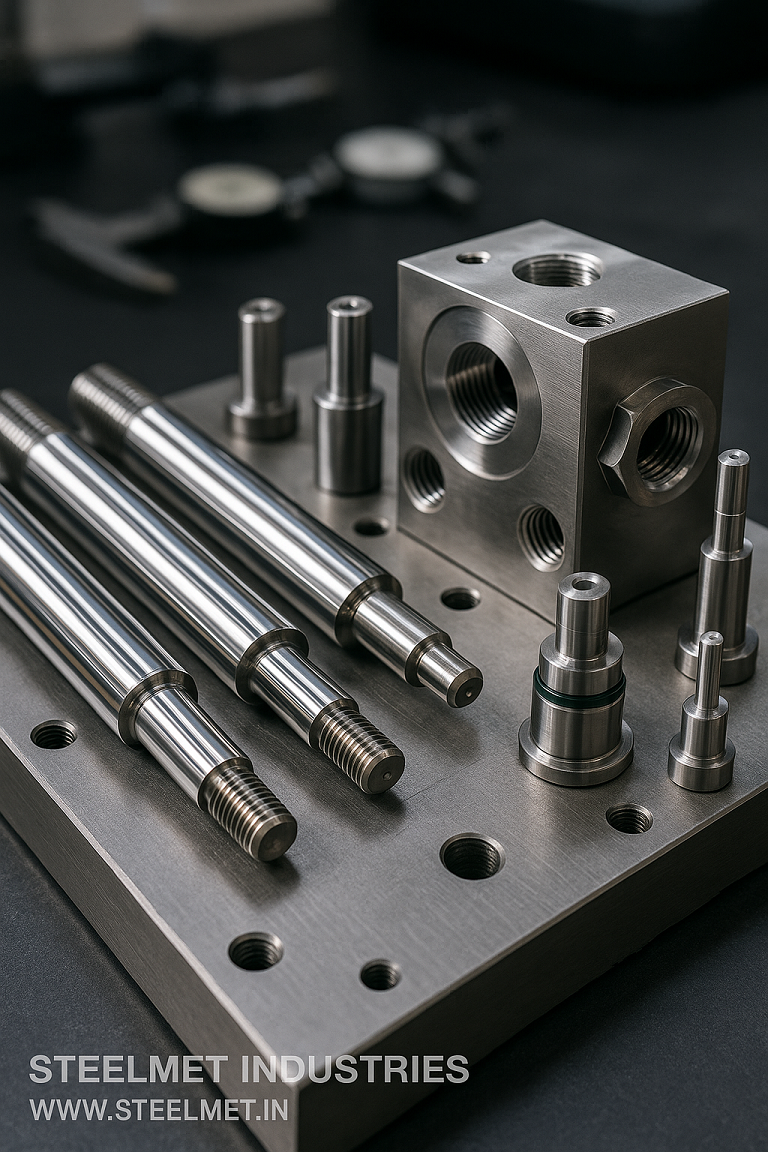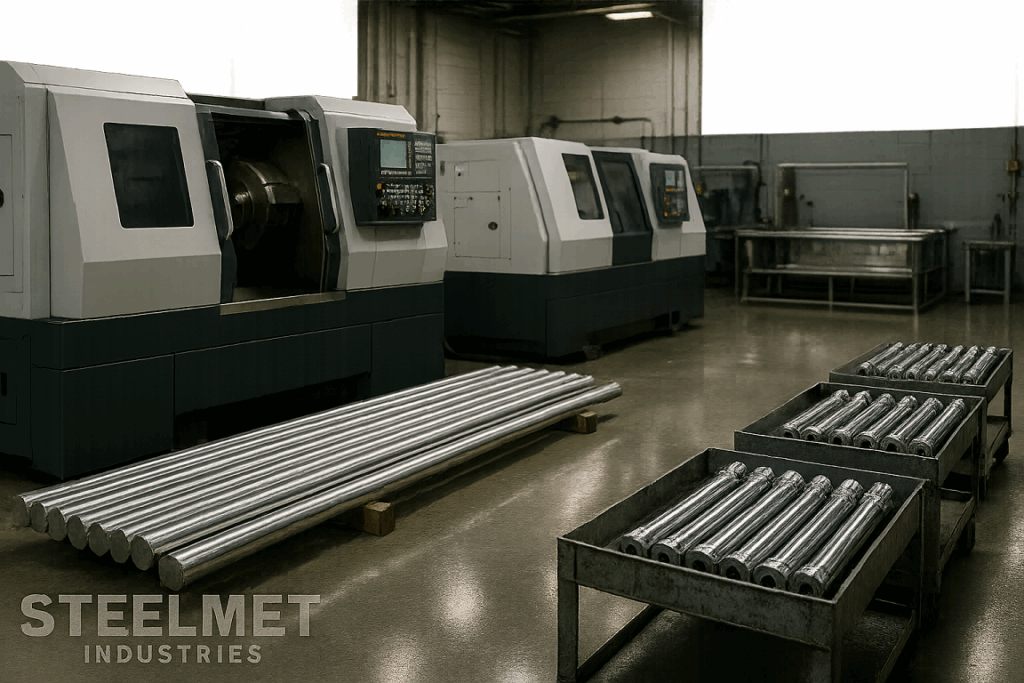Bright Steel Bars for Hydraulics & Pneumatics
Hydraulic and pneumatic systems rely on components that must operate with tight dimensional tolerances, controlled surface finish and predictable strength. Bright steel bars provide the stability needed for piston rods, spools, pump shafts and precision sliding elements. Their uniform diameter, straightness and machinability help maintain seal integrity, reduce internal leakage and support high-pressure loads in cylinders, pumps and valves.

Bright bars prepared for machining into hydraulic rods, valve spools and high-speed pump shafts.
Applications in Hydraulics & Pneumatics
- Hydraulic cylinder rods and piston rods
- Hydraulic pins, clevises and mounting components
- Valve spools and precision hydraulic elements
- Pump drive shafts and gear/vane pump components
- Pneumatic actuator rods and linear-motion parts
- Surface-treated rods (chrome, nickel, nitrided)
Component Groups & Child Pages
Hydraulic Cylinder Rods & Piston Rods
Piston rods require high surface quality for sealing, consistent diameter for bearing compatibility and strength to handle shock loads. Bright bars support precision chroming, induction hardening and tight runout limits.
Hydraulic Pins, Mountings & Clevis Components
Hydraulic mounting pins and clevis components support repeated load cycles. Bright bars reduce OD deviations that lead to accelerated bush wear and misalignment.
Valve Spools & Precision Hydraulic Components
Valve spools demand extremely tight tolerances and clean surface finish to prevent internal leakage. Bright bars provide the dimensional and metallurgical consistency needed for precision sliding fits.
Hydraulic Pump Shafts & Power Components
Pump shafts require stable microstructure, good fatigue strength and controlled dimensional variation to avoid vibration at high speeds.
Pneumatic Rods & Pneumatic Motion Components
Pneumatic components need smooth surfaces and low sliding friction. Bright bars help maintain consistent finish quality and dimensional accuracy.
Surface-Coated & Treated Rods (Chrome, Nickel, Nitrided)
Surface coatings improve corrosion resistance, wear performance and seal compatibility. Bright bars are ideal base materials for chroming and nitriding.
Why bright bars are essential for hydraulic and pneumatic performance
- Improved straightness ensures stable seal contact and reduced leakage.
- Uniform diameter enables tight fits in spools, bores and bearings.
- Better machinability helps achieve Ra values needed for seal life and sliding behaviour.
- Predictable hardenability supports induction or case hardening for rods and pins.
- Clean surface condition ensures better adhesion for chrome or nickel plating.
Real-world use case
A hydraulic cylinder manufacturer using EN19 bright bars for 40–80 mm piston rods reduced straightening operations and improved uniformity during chrome plating. When combined with Q&T heat treatment and controlled surface preparation, leakage issues from seal mismatch reduced significantly across multiple production runs.
Quick decision pointers
- For piston rods requiring surface coating: EN19 and C45 are preferred, depending on required core strength.
- For sliding-contact components like spools: Choose cleaner steels with consistent machinability such as EN8D or EN1A (for low-load applications).
- For high-speed pump shafts: EN19 (4140) or EN24 (4340) provide strong fatigue and torsional resistance.
- For case-hardened contact zones: 20MnCr5 provides deep, uniform case depth for heavy-duty wear surfaces.
Failure-prevention and quality notes
- Define pre-plating Ra requirement for chrome rods; poor finish leads to seal wear and leakage.
- Ensure induction hardening depth is consistent on heavy pins to prevent surface cracking.
- Control decarburisation during heat treatment; even minor decarb reduces fatigue strength.
- Check runout after heat treatment; distortion directly affects seal performance in cylinders.
- Define bushing compatibility hardness to avoid premature galling.
Standards & Equivalents (Table 1)
| IS | BS970 | AISI/SAE | DIN/EN | JIS | GOST | GB |
|---|---|---|---|---|---|---|
| C45 | EN8 | 1045 | C45E / 1.1191 | S45C | 45 | 45# |
| EN19 | 708M40 | 4140 | 42CrMo4 / 1.7225 | SCM440 | 40Х | 42CrMo |
| EN24 | 817M40 | 4340 | 34CrNiMo6 / 1.6582 | SNCM447 | 40ХН2МА | 34CrNiMo6 |
| 20MnCr5 | 655M20 | — | 20MnCr5 / 1.7147 | SCM420H | 20ХГ | 20CrMn |
| EN8D | 080M40 | 1040 | C40 / 1.0511 | S40C | 40 | 40# |
| EN1A / EN1AL | 230M07 | 12L14 | 11SMnPb30 | SUM22 | 10ЮТ | Y12Pb |
Grade Selection, Performance & Heat Treatment (Table 2)
| Grade | Typical Application in Hydraulics & Pneumatics | Performance Indicators | Typical Heat Treatment Route |
|---|---|---|---|
| C45 / EN8 (1045) | Used for piston rods, clevis components and moderate-load hydraulic shafts where balanced machinability and strength are needed. Suitable for chrome plating or induction hardening. | Machinability: Medium | Hardenability: Low/Medium | Wear Resistance: Moderate | Fatigue Strength: Moderate | Normalize or Q&T; induction hardening possible at wear areas. |
| EN19 (4140 / 42CrMo4) | Preferred for piston rods and pump shafts requiring high fatigue strength, good wear resistance after plating and consistent heat-treatment performance. | Machinability: Medium | Hardenability: Good | Wear Resistance: High | Fatigue Strength: High | Q&T; suitable for chrome plating and induction hardening. |
| EN24 (4340 / 34CrNiMo6) | Selected for high-speed pump shafts and heavily loaded mounting components requiring excellent toughness and deep hardenability. | Machinability: Medium/Low | Hardenability: Excellent | Wear Resistance: Very High | Fatigue Strength: Very High | Q&T; may include controlled cooling or cryogenic steps for fatigue-critical parts. |
| 20MnCr5 (case-hardening) | Ideal for sliding-contact zones such as bores, mating surfaces and spool interfaces requiring a hard wear surface with a tough, shock-resistant core. | Machinability: Medium | Hardenability: Low (for case) | Wear Resistance: High (after case) | Fatigue Strength: High (core) | Carburize + Q&T; case depth 0.8–1.2 mm (hydraulic applications). |
| EN8D / C40 | Used for lower-load hydraulic shafts, pneumatic rods and general fittings. Cost-effective option for components requiring good machinability and reasonable strength. | Machinability: Medium/High | Hardenability: Low | Wear Resistance: Moderate | Fatigue Strength: Low/Moderate | As-drawn or normalized; may be surface-treated depending on requirement. |
| EN1A / EN1AL (12L14) | Ideal for small turned components, fittings and pneumatic parts requiring rapid machining and smooth surface finish. Not for high-stress hydraulic components. | Machinability: Very High | Hardenability: Low | Wear Resistance: Low | Fatigue Strength: Low | Used in drawn condition; heat treatment not typical. |
Inspection & manufacturing checklist
- Define Ra prior to chrome plating (typically 0.2–0.4 µm for piston rods).
- Specify case hardness and depth clearly for sliding-contact parts.
- Check straightness after heat treatment; rod distortion directly affects seal life.
- Request inclusion-level control for valve spools to avoid galling and scoring.
- Use NDT where internal leakage can cause critical field failures.
Frequently Asked Questions
Which grade is best for piston rods?
EN19 (4140) is preferred for higher-strength piston rods; C45/EN8 is used in moderate-duty systems. Both respond well to chrome plating.
Why is straightness so important in hydraulic rods?
Even minor deviation affects seal contact and can cause leakage, uneven wear and reduced cylinder service life.
Is 20MnCr5 suitable for hydraulic applications?
Yes. It is used where a hard, wear-resistant case is needed on sliding surfaces with a tough core to absorb shock loads.
Contact for Hydraulic & Pneumatic Components
For piston rods, precision spools, pump shafts or surface-treated hydraulic components:
Related: Complete guide to bright steel bar applications — Heavy Engineering & Earthmoving — Industrial Machinery Components

